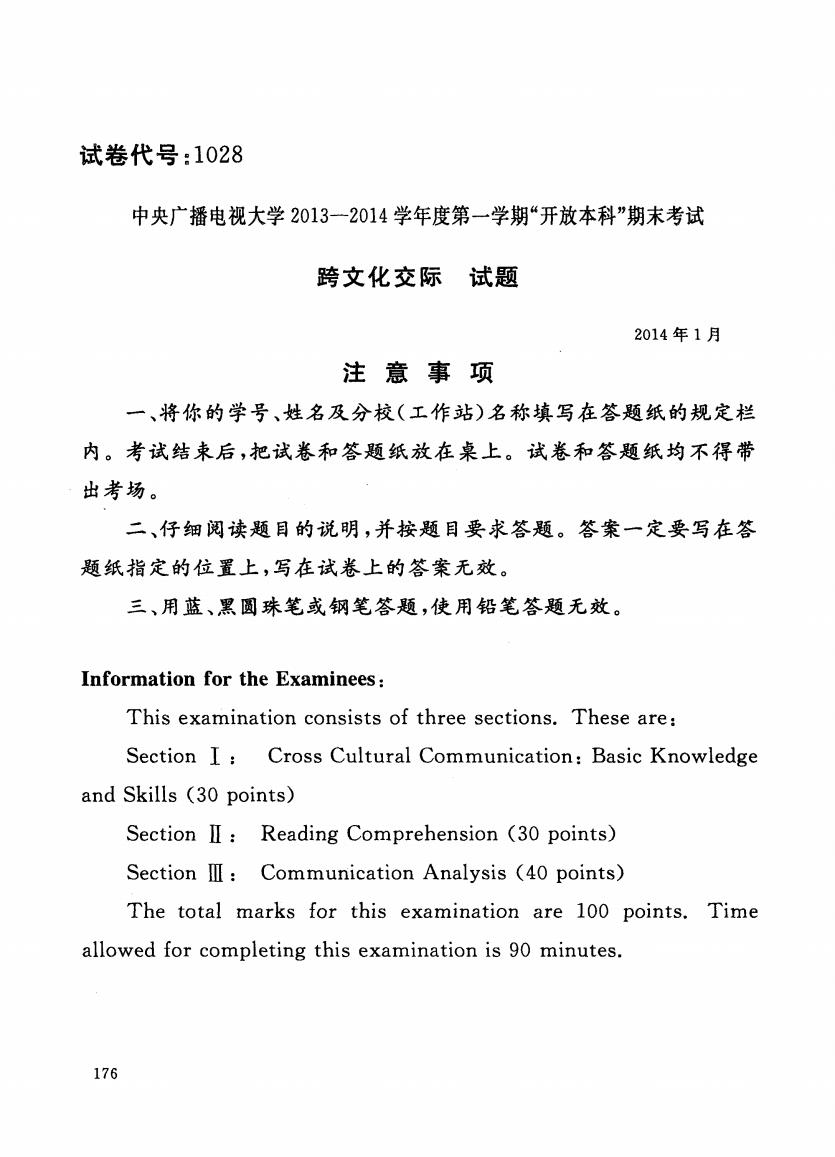
试卷代号:1028 中央广播电视大学2013一2014学年度第一学期“开放本科”期末考试 跨文化交际试题 2014年1月 注意事项 一、将你的学号、姓名及分校(工作站)名称填写在答题纸的规定栏 内。考试结束后,把试卷和答题纸放在桌上。试卷和答题纸均不得带 出考场。 二、仔细阅读题目的说明,并按题目要求答题。答案一定要写在答 题纸指定的位置上,写在试卷上的答案无效。 三、用蓝、黑圆珠笔或钢笔答题,使用铅笔答题无效。 Information for the Examinees: This examination consists of three sections.These are: Section I Cross Cultural Communication:Basic Knowledge and Skills (30 points) Section II:Reading Comprehension (30 points) Section IlI:Communication Analysis (40 points) The total marks for this examination are 100 points.Time allowed for completing this examination is 90 minutes. 176
试卷代号 中央广播电视大学 3一 4学年度第一学期"开放本科"期末考试 跨文化交际试题 2014 年1 注意事项 一、将你的学号、姓名及分校(工作站)名称填写在答题纸的规定栏 内。考试结束后,把试卷和答题纸放在桌上。试卷和答题纸均不得带 出考场。 二、仔细阅读题目的说明,并按题目要求答题。答案一定要写在答 题纸指定的位置上,写在试卷上的答案无效。 三、用蓝、黑圆珠笔或钢笔答题,使用铅笔答题无效。 Information for the Examinees: This examination consists of three sections. These are: Section I: Cross Cultural Communication: Basic Knowledge and Skills (30 points) Section II: Reading Comprehension (30 points) Section III: Communication Analysis (40 points) The total marks for this examination are 100 points. Time allowed for completing this examination is 90 minutes. 176
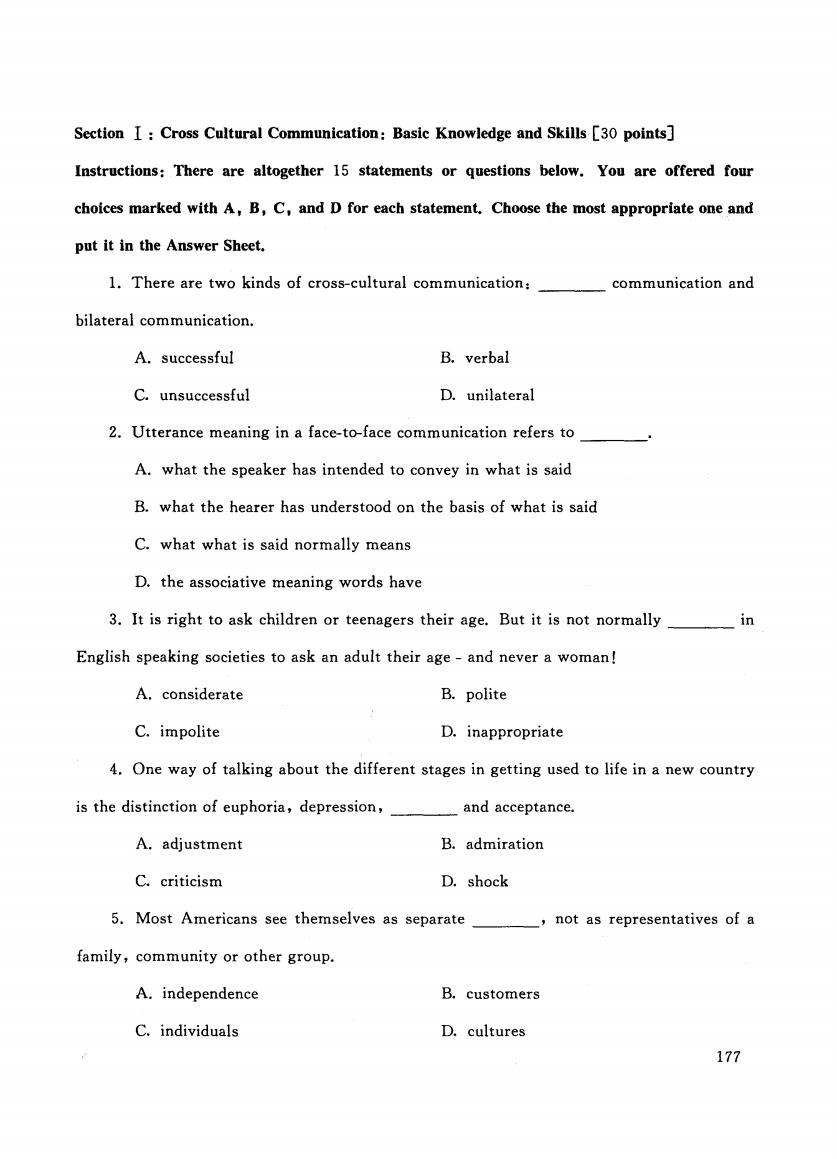
Section I Cross Cultural Communication:Basic Knowledge and Skills [30 points] Instructions:There are altogether 15 statements or questions below.You are offered four choices marked with A,B,C,and D for each statement.Choose the most appropriate one and put it in the Answer Sheet. 1.There are two kinds of cross-cultural communication: communication and bilateral communication. A.successful B.verbal C.unsuccessful D.unilateral 2.Utterance meaning in a face-to-face communication refers to A.what the speaker has intended to convey in what is said B.what the hearer has understood on the basis of what is said C.what what is said normally means D.the associative meaning words have 3.It is right to ask children or teenagers their age.But it is not normally in English speaking societies to ask an adult their age-and never a woman! A.considerate B.polite C.impolite D.inappropriate 4.One way of talking about the different stages in getting used to life in a new country is the distinction of euphoria,depression, and acceptance. A.adjustment B.admiration C.criticism D.shock 5.Most Americans see themselves as separate not as representatives of a family,community or other group. A.independence B.customers C.individuals D.cultures 177
Section I : Cross Cultural Communication: Basic Knowledge and Skills [30 points] Instructions: There are altogether 15 statements or questions below. You are offered four choices marked with A , B, C , and D for each statement. Choose the most appropriate one and put it in the Answer Sheet. 1. There are two kinds of cross-cultural communication: bilateral communication. communication and A. successful C. unsuccessful B. verbal D. unilateral 2. Utterance meaning in a face-to-face communication refers to A. what the speaker has intended to convey in what is said B. what the hearer has understood on the basis of what is said C. what what is said normally means D. the associative meaning words have 3. It is right to ask children or teenagers their age. But it is not normally in English speaking societies to ask an adult their age - and never a woman! A. considerate C. impolite B. polite D. inappropriate 4. One way of talking about the different stages in getting used to life in a new country is the distinction of euphoria , depression , A. adjustment C. criticism and acceptance. B. admiration D. shock 5. Most Americans see themselves as separate family , community or other group. , not as representatives of a A. independence C. individuals B. customers D. cultures 177
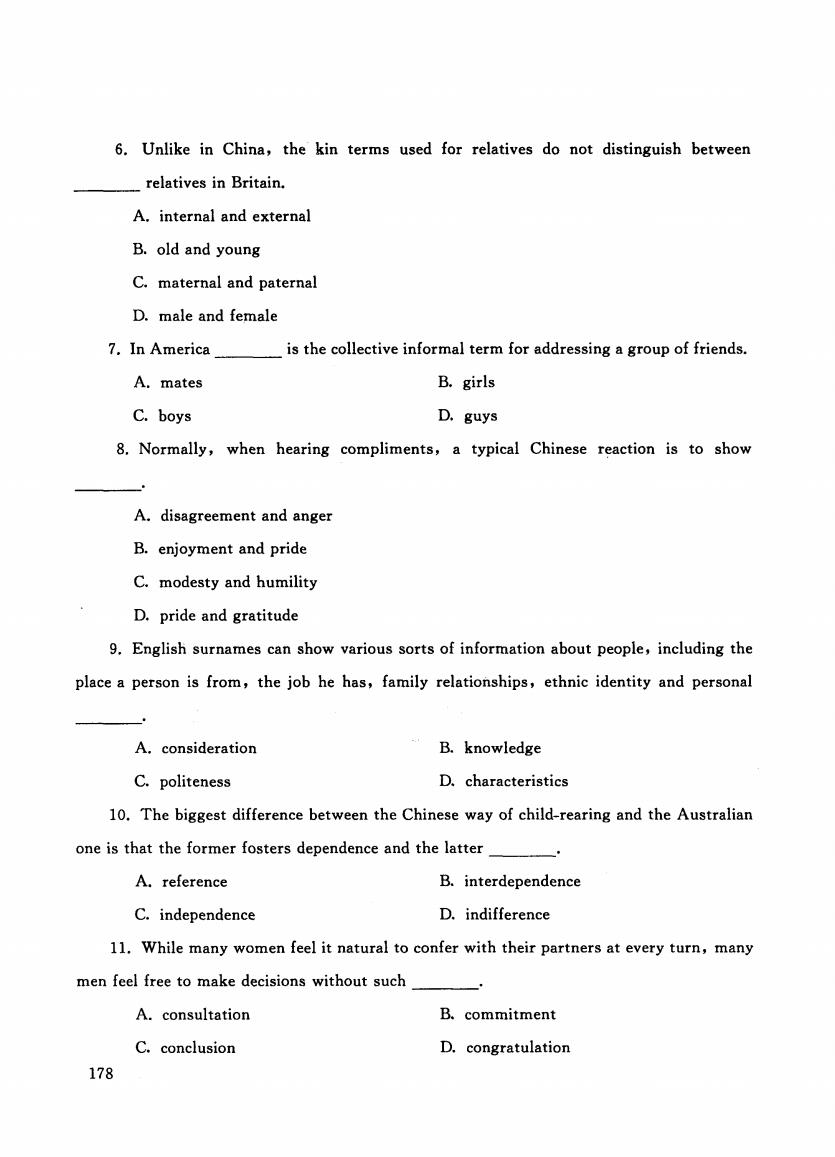
6.Unlike in China,the kin terms used for relatives do not distinguish between _relatives in Britain. A.internal and external B.old and young C.maternal and paternal D.male and female 7.In America is the collective informal term for addressing a group of friends. A.mates B.girls C.boys D.guys 8.Normally,when hearing compliments,a typical Chinese reaction is to show A.disagreement and anger B.enjoyment and pride C.modesty and humility D.pride and gratitude 9.English surnames can show various sorts of information about people,including the place a person is from,the job he has,family relationships,ethnic identity and personal A.consideration B.knowledge C.politeness D.characteristics 10.The biggest difference between the Chinese way of child-rearing and the Australian one is that the former fosters dependence and the latter A.reference B.interdependence C.independence D.indifference 11.While many women feel it natural to confer with their partners at every turn,many men feel free to make decisions without such A.consultation B.commitment C.conclusion D.congratulation 178
6. Unlike in China, the kin terms used for relatives do not distinguish between relatives in Britain. A. internal and external B. old and young C. maternal and paternal D. male and female 7. In America A. mates C. boys is the collective informal term for addressing a group of friends. B. girls D. guys 8. Normally , when hearing compliments, a typical Chinese reaction is to show A. disagreement and anger B. enjoyment and pride C. modesty and humility D. pride and gratitude 9. English surnames can show various sorts of information about people , including the place a person is from , the job he has, family relationships, ethnic identity and personal A. consideration B. knowledge C. politeness D. characteristics 10. The biggest difference between the Chinese way of child-rearing and the Australian one is that the former fosters dependence and the latter A. reference B. interdependence C. independence D. indifference 11. While many women feel it natural to confer with their partners at every turn , many men feel free to make decisions without such 178 A. consultation C. conclusion B. commitment D. congratulation
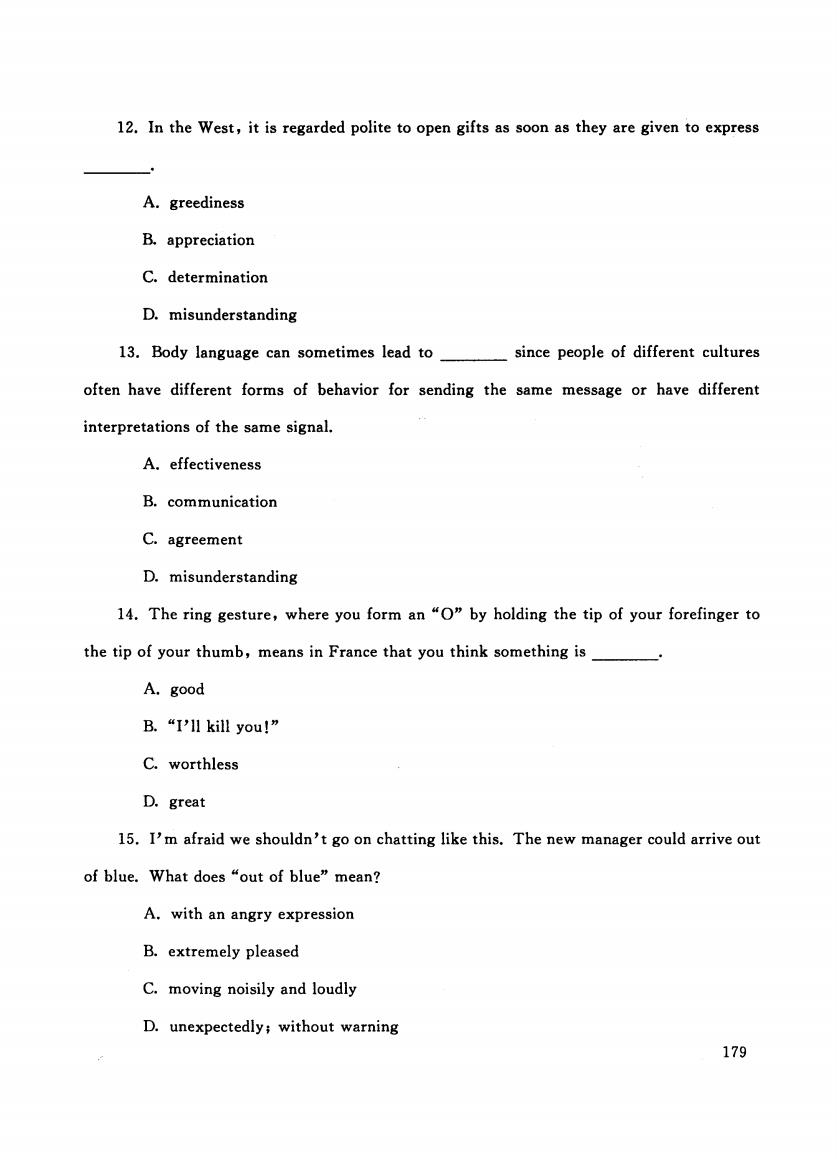
12.In the West,it is regarded polite to open gifts as soon as they are given to express A.greediness B.appreciation C.determination D.misunderstanding 13.Body language can sometimes lead to since people of different cultures often have different forms of behavior for sending the same message or have different interpretations of the same signal. A.effectiveness B.communication C.agreement D.misunderstanding 14.The ring gesture,where you form an "O"by holding the tip of your forefinger to the tip of your thumb,means in France that you think something is A.good B.“I'll kill you!” C.worthless D.great 15.I'm afraid we shouldn't go on chatting like this.The new manager could arrive out of blue.What does“out of blue'”mean? A.with an angry expression B.extremely pleased C.moving noisily and loudly D.unexpectedly;without warning 179
12. In the West , it is regarded polite to open gifts as soon as they are given to express A. greediness B. appreciation C. determination D. misunderstanding 13. Body language can sometimes lead to since people of different cultures often have different forms of behavior for sending the same message or have different interpretations of the same signal. A. effectiveness B. communication C. agreement D. misunderstanding 14. The ring gesture , where you form an "0" by holding the tip of your forefinger to the tip of your thumb , means in France that you think something is A. good B. "I'll kill you!" C. worthless D. great 15. I'm afraid we shouldn't go on chatting like this. The new manager could arrive out of blue. What does "out of blue" mean? A. with an angry expression B. extremely pleased C. moving noisily and loudly D. unexpectedly; without warning 179
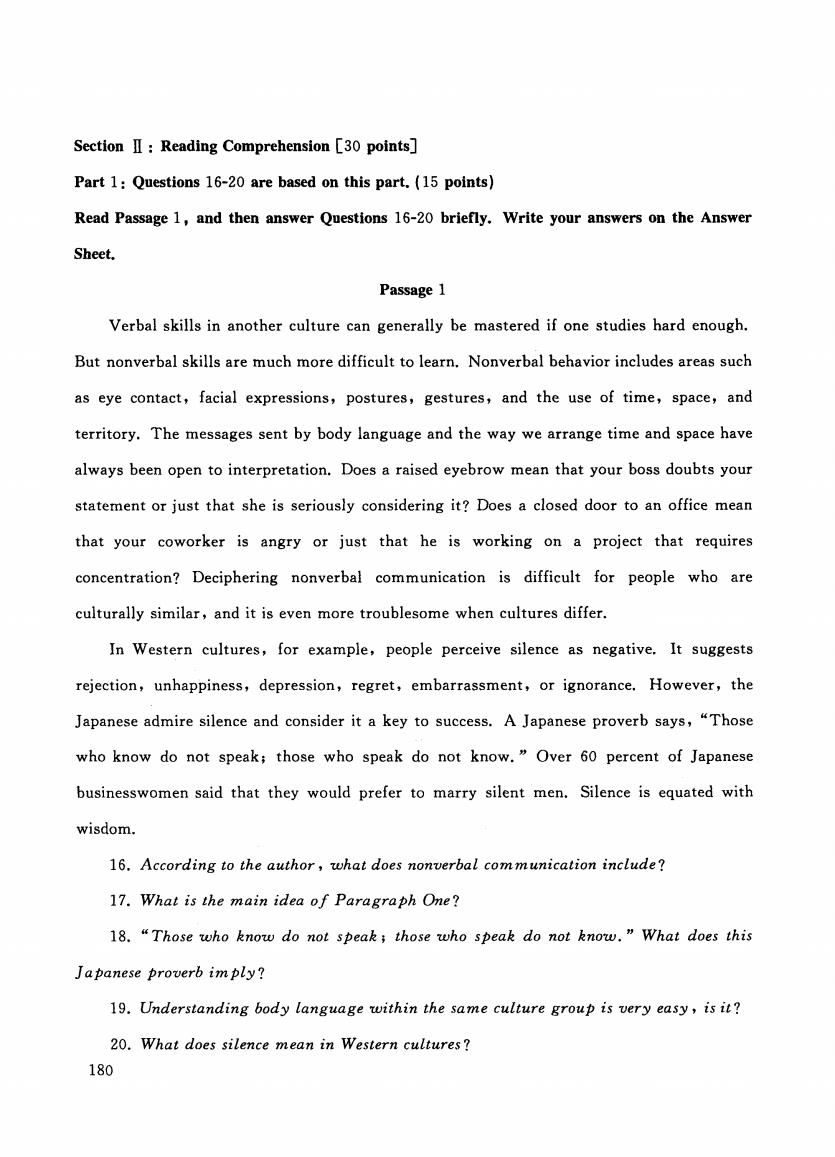
Section II:Reading Comprehension [30 points] Part 1:Questions 16-20 are based on this part.(15 points) Read Passage 1,and then answer Questions 16-20 briefly.Write your answers on the Answer Sheet. Passage 1 Verbal skills in another culture can generally be mastered if one studies hard enough. But nonverbal skills are much more difficult to learn.Nonverbal behavior includes areas such as eye contact,facial expressions,postures,gestures,and the use of time,space,and territory.The messages sent by body language and the way we arrange time and space have always been open to interpretation.Does a raised eyebrow mean that your boss doubts your statement or just that she is seriously considering it?Does a closed door to an office mean that your coworker is angry or just that he is working on a project that requires concentration?Deciphering nonverbal communication is difficult for people who are culturally similar,and it is even more troublesome when cultures differ. In Western cultures,for example,people perceive silence as negative.It suggests rejection,unhappiness,depression,regret,embarrassment,or ignorance.However,the Japanese admire silence and consider it a key to success.A Japanese proverb says,"Those who know do not speak;those who speak do not know.Over 60 percent of Japanese businesswomen said that they would prefer to marry silent men.Silence is equated with wisdom. 16.According to the author,what does nonverbal communication include? 17.What is the main idea of Paragraph One? 18."Those who know do not speak;those who speak do not know.What does this Japanese proverb imply? 19.Understanding body language within the same culture group is very easy,is it? 20.What does silence mean in Western cultures? 180
Section IT : Reading Comprehension [30 points] Part 1: Questions 16-20 are based on this part. (15 points) Read Passage 1 , and then answer Questions 16-20 briefly. Write your answers on the Answer Sh Passage 1 Verbal skills in another culture can generally be mastered if one studies hard enough. But nonverbal skills are much more difficult to learn. Nonverbal behavior includes areas such as eye contact , facial expressions, postures, gestures, and the use of time , space , and territory. The messages sent by body language and the way we arrange time and space have always been open to interpretation. Does a raised eyebrow mean that your boss doubts your statement or just that she is seriously considering it? Does a closed door to an office mean that your coworker is angry or just that he is working on a project that requires concentration? Deciphering nonverbal communication is difficult for people who are culturally similar , and it is even more troublesome when cultures differ. In Western cultures, for example , people perceive silence as negative. It suggests rejection , unhappiness, depression , regret , embarrassment , or ignorance. However, the Japanese admire silence and consider it a key to success. A Japanese proverb says, "Those who know do not speak; those who speak do not know." Over 60 percent of Japanese businesswomen said that they would prefer to marry silent men. Silence is equated with wisdom. 16. According to the author , what does nonverbal communication include? 17. What is the main idea of Paragraph One? 18. "Those who know do not those who speak do not know. " What does this Japanese proverb imply? 19. Understanding body language within the same culture group is very easy , is it? 20. What does silence mean in Western cultures? 180